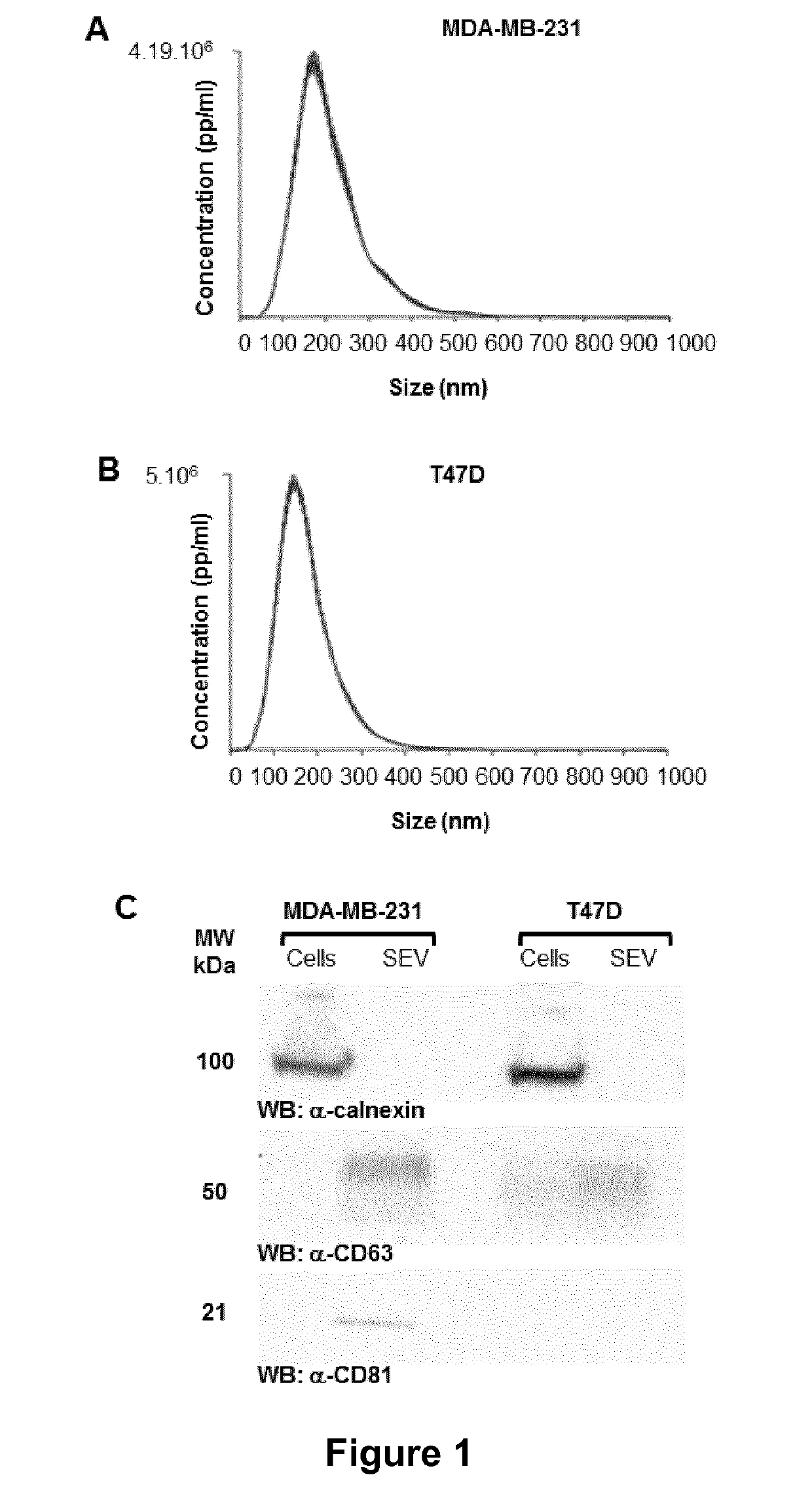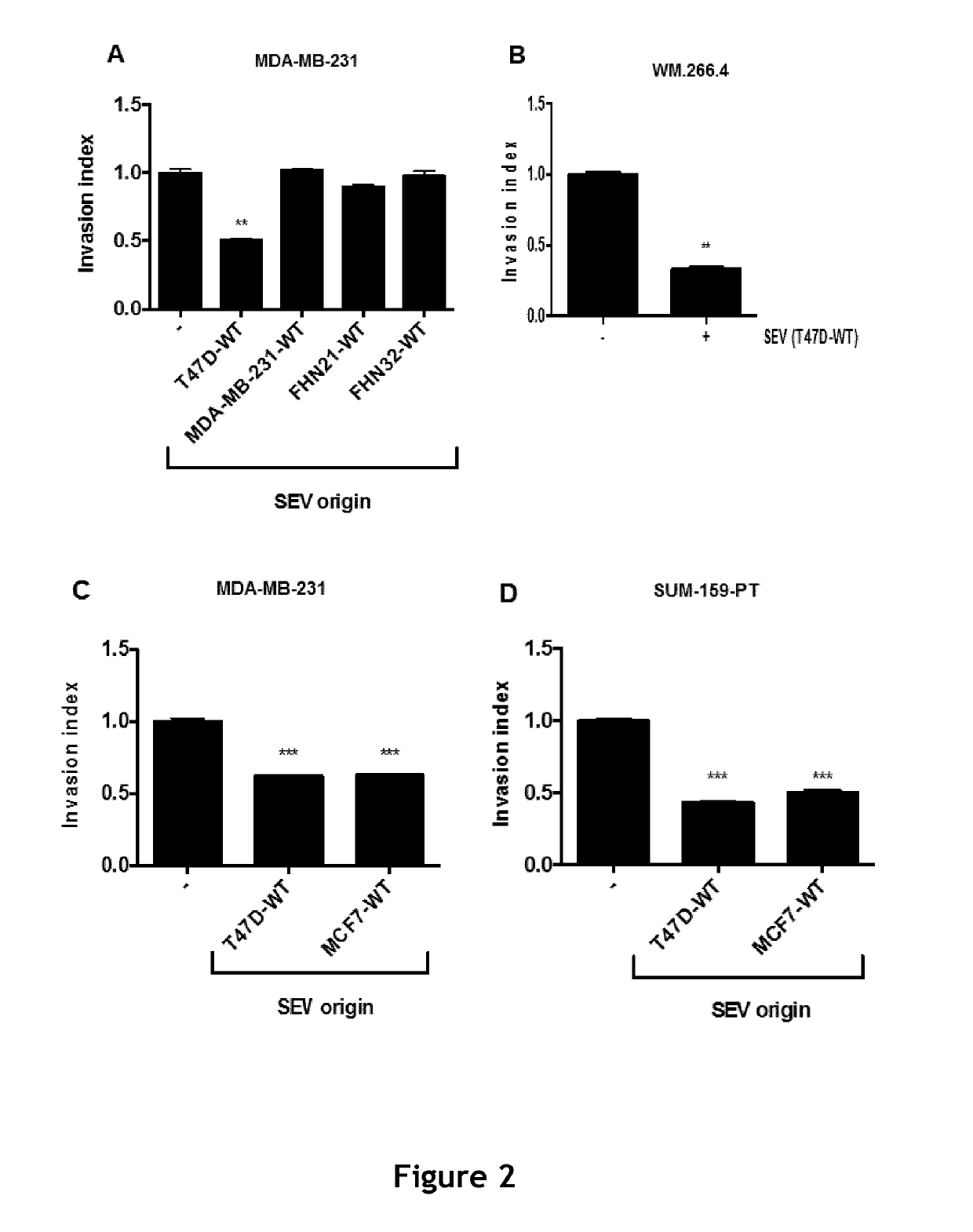Compositions comprising secreted extracellular vesicles of cells expressing nfatc4 useful for the treatment of cancer
a technology of nfatc4 and extracellular vesicles, which is applied in the field of cancer treatment, can solve the problems of no therapy no cancer treatment is effective in all patients, and the use of cancer cells derived sev appears rather deleterious than helpful for cancer treatment, so as to inhibit invasion, inhibit tumor growth and metastasis, and promote cancer progression and invasion.
- Summary
- Abstract
- Description
- Claims
- Application Information
AI Technical Summary
Benefits of technology
Problems solved by technology
Method used
Image
Examples
example 1
ced by Low Invasive Breast Cancer Cells Inhibit Cancer Progression and Metastasis
[0188]Materials and Methods
[0189]Cell Culture
[0190]The MDA-MB-231, T-47D, MCF7, NIH3T3, HEK293T cell lines were from the American Type Culture Collection, The SUM-159-PT cell line was provided by Alex Toker (Harvard Medical School), MDA-MB-231 D3H2 LN-Luc and 4T1-Red-FLuc cell lines were from Perkin Elmer. MDA-MB-231 D3H2 LN-Luc cell line was maintained in Eagle's MEM, 75 μg / ml Zeocin. 4T1-Red-FLuc cell line was in RPMI 1640, 10% Foetal Calf Serum. MDA-MB-231 and SUM-159-PT cells were maintained in Dulbecco Modified Eagle Medium (DMEM), low glucose (1 g / L D-glucose), 10% Foetal Calf Serum. T-47D and MCF7 were maintained in RPMI 1640, 10% Foetal Calf Serum. NIH-3T3 cells were in Dulbecco Modified Eagle Medium (DMEM), High glucose (4.5 g / L D-glucose), 10% Newborn Calf Serum. The HEK293T cell line was maintained in Dulbecco Modified Eagle Medium (DMEM), High glucose (4.5 g / L D-glucose), 10% Foetal Calf Ser...
example 2
ced by Modified Autologous or Not Fibroblasts Inhibit Invasion
[0387]Since expression of NFAT3 by low invasive breast cancer cells has been found to be critical for SEV from these cells to inhibit cancer progression and metastasis, the ability of healthy fibroblasts induced to express NFAT3 to inhibit cancer progression and metastasis is further tested.
[0388]On this basis, a schematic diagram of the proposed therapy development is represented in FIG. 10.
[0389]Materials and Methods
[0390]Unless otherwise specified, for corresponding tests, the same protocols as in Example 1 are used.
[0391]Fibroblasts Isolation from Balbc Mice Skin.
[0392]Skin from shaved Balbc mice will be put in Dispase II (Sigma; #000000004942078001) overnight at 37° C. 5% CO2. 24 h after, dermis will be separated from the epidermis and dermis will be cut in very little parts and let it stick on a plastic culture plate. Then 10 ml of Dulbecco Modified Eagle Medium (DMEM), High glucose (4.5 g / L D-glucose), 10% Foetal C...
example 3
[0406]Materials and Methods
[0407]Lentivirus Plasmid Construction
[0408]The following expression vectors of Example 2 has been used:[0409]pLVX-tdTomato-C1 (Clonetech, empty vector, also referred to as “to-Ctl”): SEQ ID NO:28, encoding protein tdTomato-C1 of sequence SEQ ID NO:34;[0410]pLVX-tdTomato-C1-HA hNFAT3 WT (expression vector of isoform 2 of NFATC4, as defined in Table 1 above, also referred to as “to-NFAT3 WT”): SEQ ID NO:29, encoding protein tdTomato-C1 of sequence SEQ ID NO:35;[0411]pLVX-tdTomato-C1-HA hNFAT3-85C (expression vector of isoform 2 of NFATC4, as defined in Table 1 above, truncated of the 85 C-terminal amino acids, also referred to as “to-NFAT3-85C”): SEQ ID NO:30, encoding protein tdTomato-C1 of sequence SEQ ID NO:36;[0412]pLVX-tdTomato-C1 htNFAT3 WT (expression vector of isoform 2 of NFATC4, as defined in Table 1 above, truncated of the 521 N-terminal amino acids, also referred to as “to-ΔNFAT3”): SEQ ID NO:31, encoding protein tdTomato-C1 of sequence SEQ ID NO...
PUM
 Login to View More
Login to View More Abstract
Description
Claims
Application Information
 Login to View More
Login to View More - R&D Engineer
- R&D Manager
- IP Professional
- Industry Leading Data Capabilities
- Powerful AI technology
- Patent DNA Extraction
Browse by: Latest US Patents, China's latest patents, Technical Efficacy Thesaurus, Application Domain, Technology Topic, Popular Technical Reports.
© 2024 PatSnap. All rights reserved.Legal|Privacy policy|Modern Slavery Act Transparency Statement|Sitemap|About US| Contact US: help@patsnap.com










